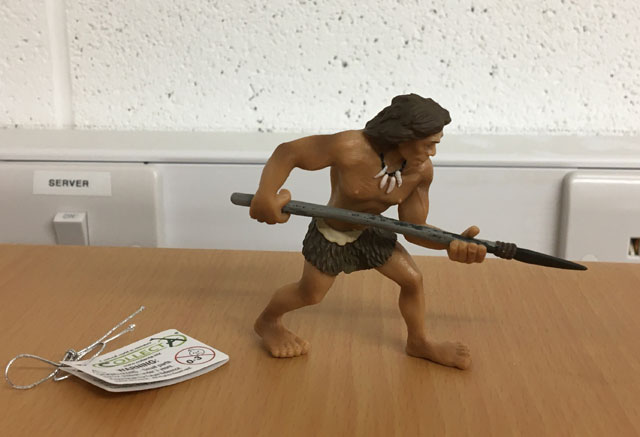Ancient Hominids could Kick Butt According to New Study
Ancient Hominids Physically Much more Powerful than Modern Humans claims Anthropologist
Despite improvements in nutrition, medicine and even with modern training techniques and supplements today’s top athletes would be no match for some of our ancestors a leading anthropologist has claimed.
Modern humans would lose out in physical contests against ancient humans and against other species on the hominid family tree, that is the claim by the anthropologist Peter McAllister in his new book entitled “Manthropology: The Science of Inadequate Modern Man”. Whilst we can understand some of the headline grabbing information provided in the various press releases to publicise the launch of this particular book, once an understanding of certain hominid species is gained, the hypothesis suggesting that modern humans are wimps in comparison to our ancestors is not very surprising.
For example, in Peter’s book he states that a Neanderthal woman could beat Arnold Schwarzenegger in an arm wrestle.
Ancient Hominids
Not wishing to put a damper on the Governor of California’s physical prowess, we are sure that Mr Schwarzenegger at his peak would have been very strong. However, Neanderthals do have some anatomical advantages that might just give them the edge if an armwrestling contest was ever to be held. For example, although Neanderthals were shorter than most modern humans (males about 1.70 metres tall, females about 1.52 metres), they were stockily-built and heavily muscled. Evidence of the heavy musculature appears in the extremely large muscle attachment scars on the fossil bones and the bowing of some of the limb bones. A male Neanderthal would have weighed around 80 kilogrammes and both sexes would have been immensely strong. Studies of the fingers and wrist bones show that they had a much more powerful grip than a modern human. Their strong muscles, squat stature and the different proportions in the arm bones, particularly the shorter lower arm would give a Neanderthal female a distinct advantage in a strength contest against a bodybuilder such as Mr Schwarzenegger.
Studies of “Boxgrove Man”
Studies of “Boxgrove Man”, believed to be 500,000 year-old fossil remains and other evidence of Homo heidelbergensis found in West Sussex give an indication of just how big and strong some of our ancestors were. A tibia (shin-bone) discovered at Boxgrove in 1993 is massive in its proportions and strength. It is believed to have belonged to a male, well over 1.80 metres tall and easily weighing 80 plus kilogrammes. The site revealed the remains of complete animal carcases that had been butchered at that location. There was the fossils of a complete horse, two rhinoceros, each one weighing an estimated 700 kilogrammes, yet these animals had been killed and then carried back to this site and then cut up for food.
Homo neanderthalensis Model

Selecting a CollectA Neanderthal man figure for an Everything Dinosaur customer. Picture credit: Everything Dinosaur.
Picture credit: Everything Dinosaur
To view models of ancient hominids including Neanderthals: CollectA Prehistoric Animal Models and Figures.
It is not only the Neanderthals and H. heidelbergensis that come out on top in physical contests against our own species, our ancestors too, were capable of some amazing physical feats. Mr McAllister has also studied the preserved footprints of aborigines in Australia and his work suggest that they were capable of running at up to 23 mph, bare foot and over soft mud in their pursuit of prey.
The prints of six men chasing prey and Mr McAllister’s study of them leads him to believe these men if trained and provided with modern running shoes could beat Usain Bolt in a sprint. Peter claims that these ancient ancestors of ours could theoretically reach sprinting speeds of up to 28 mph.
Usain Bolt reached 26mph at last year’s Beijing Olympics, but Mr McAllister claims that with modern training and spiked running shoes, an aboriginal man would be capable of 28mph.
The anthropologist blames modern lifestyles for our decline in speed and power.
He says in his book:
“At the start of the industrial revolution there are statistics about how much harder people worked then. The human body is very plastic, and it responds to stress. We have lost 40 per cent of the shafts of our long bones, because we have much less of a muscular load placed upon them them”.
This is very true, you only have to read accounts of working people’s lives 100 years ago to learn how long and how hard they had to work. Some of the old farmers in Cheshire remember, how their fathers and grandfathers worked in the days before tractors and modern machinery. Gathering the harvest was extremely hard work, with some of the corn crops cut with scythes. I remember being told the tale by one very old gentleman, that in the days before WWII when the reaper binder was still not that common on small holdings, a man’s worth was measured in how much corn he could cut in a day. Compared to the lives of our grandparents, we modern humans have it relatively easy with our office jobs and commuter lifestyles. Still, studies of the skeletons of people dating from the Middle Ages indicate that we 21st Century folk are certainly a lot taller and healthier than that particular group of people from human history. In fact, modern people are about us tall as our human ancestors from the New Stone Age, but we certainly did not have to work as hard to get our daily bread. One thing is for sure we certainly lived longer, a Neolithic person could perhaps hope to reach 35-40 maybe, for us, scientists are predicting in twenty years time, reaching 90 years of age and beyond will be much more commonplace.

